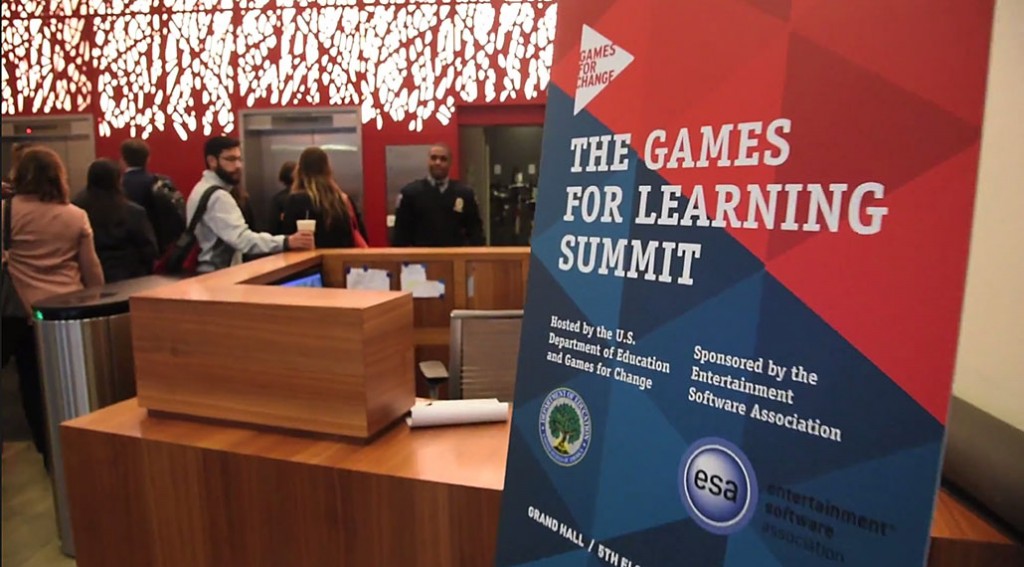
The Games for Learning Summit drew dozens of developers, educators and researchers to New York to discuss how to unlock the power of games in school.
Looking back at this year’s Games for Change conference in New York it’s interesting to consider the evolving role games and learning is playing among those seeking to use games for all sorts of social goods.
In the past keynotes and panels dotted the G4C schedule, but this year nearly all of the games for learning content was packed into a one-day, invite-only Games for Learning summit hosted by the U.S. Department of Education and Games for Change and sponsored by Entertainment Software Association.
So why the change from previous years? Asi Burak, president of Games for Change says that this year’s summit was an experiment of sorts. The intention is to open the G4L summit to more participants next year, and “actually expand the learning program, not reduce it,” said Burak.
Here are some of the things we saw and heard from the Games for Learning Summit:
According to Burak, interest in the games-based learning movement has grown to be more thant 50 percent of the interest at G4C. So when the DOE approached G4C with the opportunity, the conference jumped at the chance.
“We’re good and bringing the community together and they [the Department of Education] brought the best game makers and the best educators,” Burak said, stressing this summit was an experiment.
Many at the summit noted that this was the first time a government agency was taking a very public stance on the power of games for learning. But for Department of Education folks in New York, the reasons for taking that stand are obvious.
For one, they said they believe it can level the playing field between learners of different levels. It can also increase engagement among those students who are less engaged.
“We’re bringing together people who are in different silos. We have some great educational researchers. We have some fantastic game developers. We have folks from the game industry and government and we’re bringing them together because we need them to work together to answer some really persistent challenges in the education space that we think games really have the potential to solve,” Richard Culatta, director of technology at the Department of Education, told gamesandlearning.org.
Culatta also cited the fact that programs like Connect2Compete are helping economically challenged school systems access the Internet and digital tools. That connectivity, he argued, creates an immense opportunity to make real strides in education. It levels the playing field for schools who do have access vs. don’t have access. Now all can take advantage of new technologies and tools.
But Culatta was also quick to identify the real challenges that face those hoping to use games to address the classroom.
We need to make sure that the games we are creating are really tackling the tough problems we have in education… We also have the challenge of measuring what is working. It’s not good enough just to have a fun game. We have to be able to show it makes a difference.
–Richard Culatta, U.S. Department of Education
Since there was much more interest in the summit than anticipated, organizers ended opening the plenary sessions to a live stream audience of over 200 participants.
Many at the summit seemed to believe the right mix of people were in the room — From government officials, to developers, educators to investors. Each session sought active participation from the audience. But of course, as with all conferences the real value was in the conversations that took place in the hallways and sidelines.
Amy Robinson, creative director for of Eyewire, said the opportunity to reach across different sectors was a critical opportunity the summit created. She noted to our team that was able to make great connections to help move Eyewire to the next level.
The biggest take away – nearly all the folks we spoke with seemed to believe that the GBL community understands that you need to create a game that is fun and engaging- and they’re all working towards that.
However, they note, that the biggest hurdle / obstacle in making GBL go mainstream is solving the distribution piece.
“How do we create a pathway so some brilliant person wants to make a great education game then get that game into schools or to parents,” Mark DeLaura, former senior advisor at the White House Office of Science and Technology Policy, said. “So what is the distribution system? What is the marketplace for those people?”
